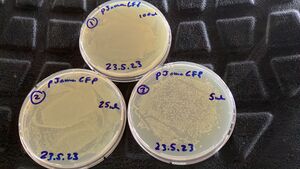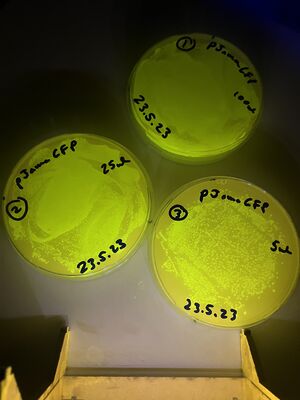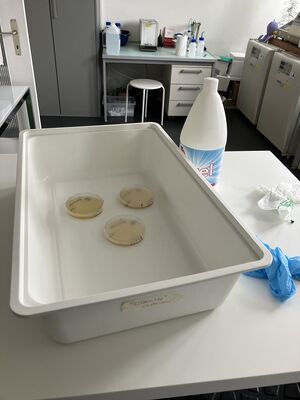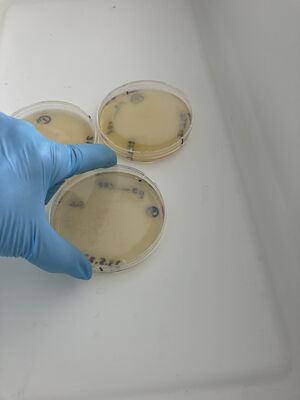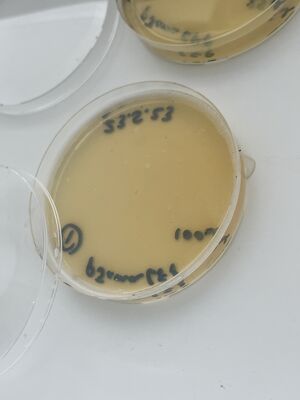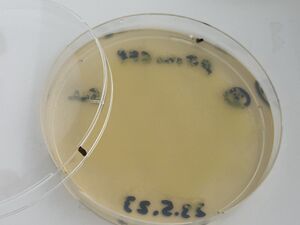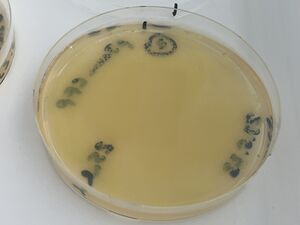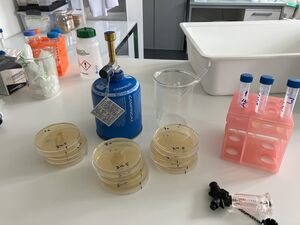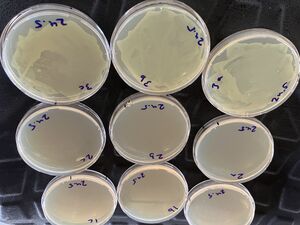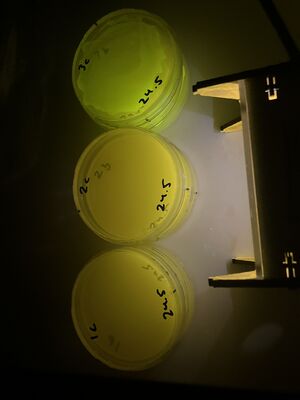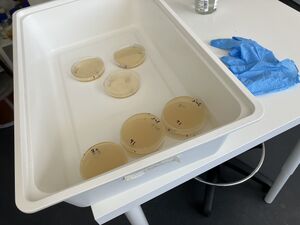Validated GMO inactivation
In order to more formally validate the usual GMO inactivation done with bleach for disposal of plates and cultures, we did more documented experiments that are being visually summarised in this page. The validations were performed with commercial bleach (Coop 'Prix Garantie') and are applicable to both GMO bacteria and nematode worms transformed with antibioticR plasmids. It is directly specific for this SOP of the lab collection.
As always, precautions in using bleach and appropriate personal protective equipment (lab coat, gloves, and eye protection) are an essential part of this inactivation method.
The big white tray - labelled 'clean up' - was used, as usual for all manipulations.
The validation for bacterial plates was done upon bacteria transformed with a pJAMA-GFP plasmid, which make bright green fluorescent colonies...
A fresh 2ml culture was used to make three plates of cultures on growth media carrying the selective antibiotic, ampicillin (LB-amp100 plates). A glass spreader was used - from a bent pasteur pipette, to distribute the following liquids.
1, with 100ul of culture (full lawn)
2, with 25ul of culture (less bugs)
3, with 5ul of culture (still too many to count)
These are shown below:
Our 'DIY illuminator' with bright blue LEDs, and an amber filter (held in front of a phone camera) was used to get the fluorescence image.
Then, the plates were treated with bleach in the big white tray.
Three conditions of inactivation for this validation experiment were run: full strength bleach, for plate 1, 1/10 bleach in water for plate 2, and water only for plate 3, with the least colonies.
5ml of each solution was added to the appropriate plate, incubated for 5min and then swirled, as shown below, and incubated 5 more minutes.
Then, after waiting 5 more minutes, a couple of mls of the liquid from each plate was recuperated into small conical tubes (15ml) with sterile serological pipets and the old Drummond pipet-aid. On plate 1, all colonies appeared fully dissolved by the undiluted bleach, but plate 2 with 1/10 bleach, and plate 3, with only water, still had intact colonies, as shown.
From the recuperated liquids, three more fresh plates were made by inoculating 50ul of each liquid taken after the treatment, as shown.
After all that, a repeat of the inactivation of all three initial plates, as per the SOP, with 100% javel put also on plate 2 and 3 was performed (esp as it was clear even the 1/10 solution is not dissolving the colonies, like the full strength one. The liquids were inactivated with fresh bleach for disposal, and the 'clean up' tray was carefully washed in the big sink, as usual (around back, in the intermediate Polymeka space).
The 9 new plates were incubated overnight at 37oC and checked for growth.
In the end, the experiment validated our ordinary inactivation method very well but provided some surprises.
No colonies were found on the new triplicate plates from either the 1st or 2nd treatment conditions. That condition 2 worked so well, also giving no colonies on these secondary plates, as the original colonies did not dissolve with 1/10 javel, was quite a surprise. (In terms of reducing risk, however, it still seems better to use 100% bleach, as in the SOP.) Only the water treatment gave growth on the new plates.
Here is an image of all 9 plates, in ordinary light.
Here is the fluorescence image (stacks of 3 plates).
No colonies were seen on these secondary plates exposed to bleach, even from the liquid recuperated from the plate treated with 1/10 bleach.
We note in the experiment that we could also have tried to recuperate plasmids from the treated liquids, but that further test would only provide very useful information if very good competent cells were used. (sort of a waste)
No new colony growth even for the 1/10 treatment seemed quite satisfactory...
Finally, all secondary plates were inactivated as usual, according to the SOP, for proper disposal in the ordinary trash (one last picture here).
A similar validation was performed with transformed C. elegans 'worm' cultures, to be put on a new page.
A more formal report of the validation tests can also be read here.
